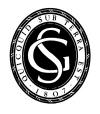| Online: | |
| Visits: | |
| Stories: |

| Story Views | |
| Now: | |
| Last Hour: | |
| Last 24 Hours: | |
| Total: | |
Door eleven
 Durham wasn’t the only building to make it into our list of 100 Great Geosites – London’s Westminster Abbey also appears, both as a place to see some beautiful geology, and a burial place for many of geology’s famous faces.
Durham wasn’t the only building to make it into our list of 100 Great Geosites – London’s Westminster Abbey also appears, both as a place to see some beautiful geology, and a burial place for many of geology’s famous faces.
Geologists memorialised in the Abbey include William Buckland (1784-1856), Charles Darwin (1809-1882), Charles Lyell (1797-1875) and John Woodward (1665-1728). You can also visit a memorial to Humphry Davy (1778-1829), one of the Geological Society’s original thirteen founders, and Michael Faraday (1791-1867), who is buried in another of our unusual 100 Great Geosites, Highgate Cemetery.
Our own Assistant Librarian Wendy Cawthorne took these images of Westminster Abbey, lit up at night.
The Sanctuary Pavement
As well as the opportunity to pay homage to some famous geological names, Westminster Abbey is a geosite worth visiting for its beautiful variety of building stones. UCL’s Ruth Siddall, who leads urban geology tours in London, describes the newly restored Sanctuary Pavement, which lies at the heart of the Abbey church.
‘Envisioned and created by King Henry III in the late 13th Century, the pavement features a variety of beautiful stones.
‘Designed to commemorate the translation of the bones of St Edward the Confessor from the crypt to a new shrine (situated behind the High Altar) the pavement is in the Cosmatesque style which had been popular in Rome over the preceding two centuries.
‘Cosmatesque floors may be described as a ‘patchwork quilt’ of stones. Unlike mosaic where the stone pieces are all small cubes, Cosmatesque designs feature stones of different shapes fitted together to make a pattern. The materials used in Cosmati work were decorative stones (marbles and porphyries) and glass laid in a bed of mortar. Typically it appears that stones were ‘acquired’ from Roman-period archaeological sites and recut to form pieces.
‘The decorative building stones used in the Abbey include Pubeck marble, green and purple porphyry, africano (red and black marble breccias), alabaster, Ammontico Rosso, Black Coralline Limestone, Breccia Corallina, Carrara Marble, Egyptican Gabbro, Tadcaster Limestone and Verde Genova, a green serpentinite.’
You can see Ruth giving tours of the Cosmati Pavement on the Westminster Abbey website.
![]()
Source: http://blog.geolsoc.org.uk/2015/12/11/door-eleven/









